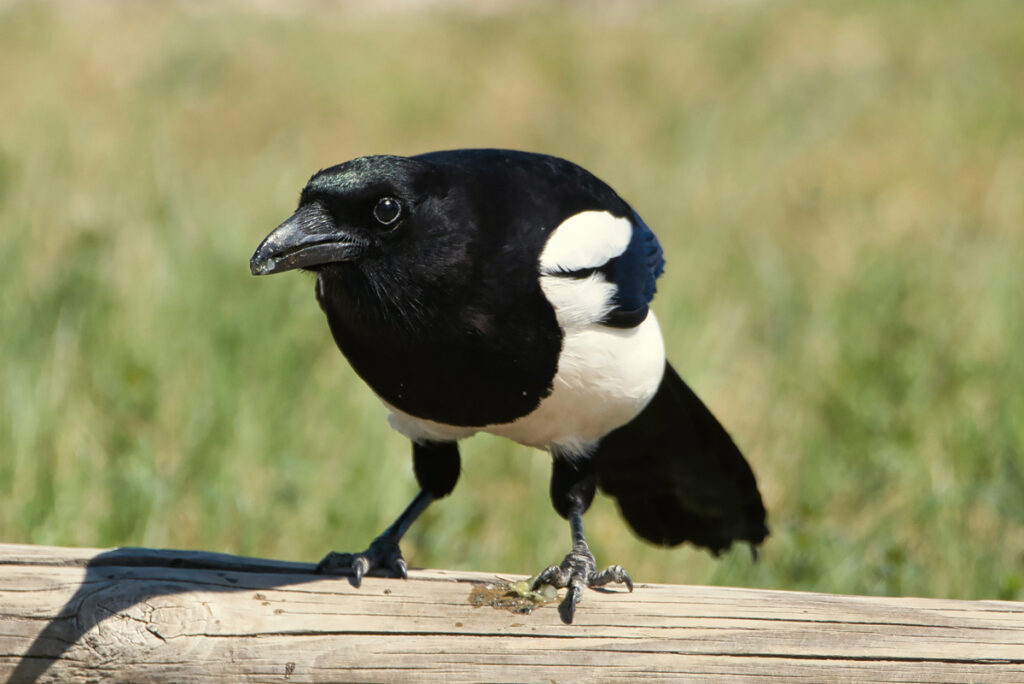
They’re ubiquitous across all of Taos County, and some have even been spotted as far South as Santa Fe. Even when you can’t see them, the cacophony of their calls is impossible to ignore. They are black-billed magpies, and despite efforts in the early 20th Century to wipe them out through poisoning and trapping, they remain a Western mainstay. Despite their unassuming appearance and eccentric behavior, magpies were branded by ranchers and farmers as cold-blooded murderers even as late as 1965 when Treasury of Hunting accused them of swooping in to pluck the eyes out of newly born livestock. They maintained that as a flock (or parliament in magpie’s case) they would then ravenously devour the newborn and leave a clean carcass behind. In reality, magpies mostly eat insects. They won’t turn up their beaks at a morsel of meat should a carcass present itself, but they prefer to let larger animals do the killing for them.
Ranchers blamed livestock losses on “ferocious” magpies eating entire cows alive. The consensus held they were rapaciously bloodthirsty little monsters who ought to be wiped out at the earliest convenience. States sanctioned and even endorsed the war against magpies, with states like Idaho and North Dakota offering a bounty for each magpie brought in. Magpie populations were depleted by hundreds of thousands until they were given federal protection by being added to the Migratory Bird Act in 1973, ending state-sanctioned bounties and limiting the killing of magpies only to when they are causing direct property damage. What constitutes direct property damage isn’t explicitly defined, and people sometimes justify their culling on the basis that the offending magpies were eating from their fruit trees or pecking at a window.
While magpies survived this extermination campaign, their numbers have steadily declined with each passing year, losing about 38% of their total population between 1966 to 2019.The Cornell Lab of Ornithology blames some of this loss on pesticides, particularly the use of topical pesticides on livestock. Magpies share a symbiotic relationship with cattle, landing on their backs to peck out a buffet of ticks, and when pesticides were introduced they ended up ingesting these toxic chemicals.
Considering how commonplace sightings of magpies are in our area, it’s easy to dismiss them as mundane, but in fact they are quite extraordinary. Few species outside of humans can recognize their own reflection in a mirror, and magpies are part of this exclusive club. A 2008 study had researchers placing colored stickers on magpies and then showing them their reflections, the sight of which caused the birds to start scratching at the stickers on their bodies to take them off. With a brain to body ratio exceeded only by humans, magpies are thought to be not just one of the smartest birds but one of the most intelligent animals on the planet.
Magpie parents will portion out food for their young using tools they sharpen themselves, parliaments of magpies will form a collective strategy to get food, and their calls can express anger, disapproval, and rally nearby magpies for food or to fend off an intruder. Magpies in captivity have even learned to imitate human speech (check out Pie the magpie on YouTube for an example). Their most noted intelligent behavior is the so-called magpie funeral: When a magpie discovers a fallen comrade, it will call out to all neighboring magpies, who in turn begin bringing small twigs and sticks to lay beside the body and loudly call out to each other in mourning for as long as 15 minutes before flying away together in a silent procession.
These behaviors not only demonstrate intelligence, they also beg the question of what other characteristics we have yet to learn or observe in magpies. It wasn’t until 1999 that a magpie was observed mimicking human speech, and no study has been performed to test if they have any understanding of what they’re saying.
Don’t discard magpies for how common they are, their behaviors and personality make them truly unique.
Author
-

Bryce Flanagan moved from Sacramento, CA to Taos County in 2016, and has lived in Questa for two years. He's passionate about the unique and beautiful wildlife of our state and is a regular contributor to the Questa Del Rio News.
View all posts



